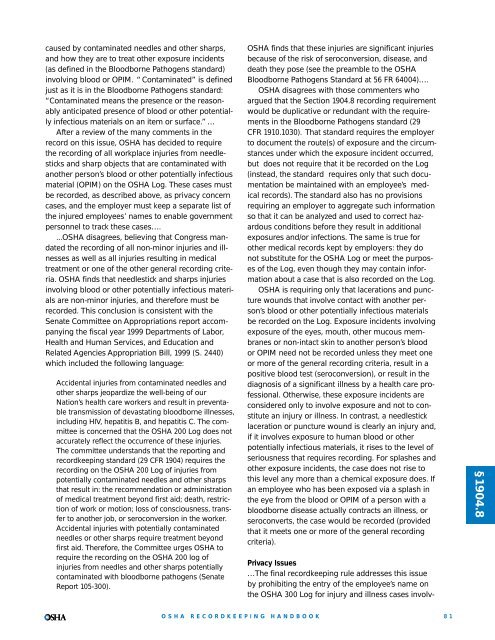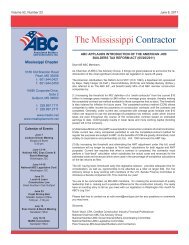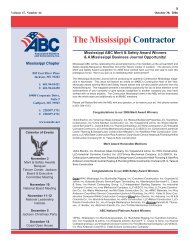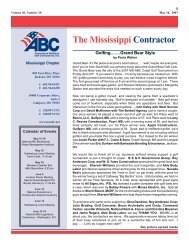§1904.8exposure” as these terms are defined in <strong>OSHA</strong>’sBloodborne Pathogens standard (29 CFR 1910.1030).These injuries are of special concern to healthcareworkers because they use needles and other sharpdevices in the performance of their work duties andare therefore at risk of bloodborne infections causedby exposures involving contaminated needles andother sharps. Although healthcare workers are at particularrisk of bloodborne infection from theseinjuries, other workers may also be at risk of contractingpotentially fatal bloodborne disease. Forexample, a worker in a hospital laundry could bestuck by a contaminated needle left in a patient’s bedding,or a worker in a hazardous waste treatmentfacility could be occupationally exposed to bloodbornepathogens if contaminated waste from a medicalfacility was not treated before being sent towaste treatment.Section 1904.8(a) requires employers to record onthe <strong>OSHA</strong> Log all work-related needlestick andsharps injuries involving objects contaminated (orreasonably anticipated to be contaminated) withanother person’s blood or other potentially infectiousmaterial (OPIM). The rule prohibits the employerfrom entering the name of the affected employee onthe Log to protect the individual’s privacy; employeesare understandably sensitive about others knowingthat they may have contracted a bloodborne disease.For these cases, and other types of privacy concerncases, the employer simply enters “privacy concerncase” in the space reserved for the employee’s name.The employer then keeps a separate, confidential listof privacy concern cases with the case number fromthe Log and the employee’s name; this list is used bythe employer to keep track of the injury or illness sothat the Log can later be updated, if necessary, and toensure that the information will be available if a governmentrepresentative needs information aboutinjured or ill employees during a workplace inspection(see Section 1904.40). The regulatory text ofSection 1904.8 refers recordkeepers and others toSection 1904.29(b)(6) through Section 1904.29(b)(10)of the rule for more information about how to recordprivacy concern cases of all types, including thoseinvolving needlesticks and sharps injuries. The implementationsection of Section 1904.8(b)(1) defines“other potentially infectious material” as it is definedin <strong>OSHA</strong>’s Bloodborne Pathogens Standard (29 CFRSection 1910.1030, paragraph (b)). Other potentiallyinfectious materials include (i) human bodily fluids,human tissues and organs, and (ii) other materialsinfected with the HIV or hepatitis B (HBV) virus suchas laboratory cultures or tissues from experimentalanimals. (For a complete list of OPIM, see paragraph(b) of 29 CFR 1910.1030.)Although the final rule requires the recording ofall workplace cut and puncture injuries resulting froman event involving contaminated sharps, it does notrequire the recording of all cuts and punctures. Forexample, a cut made by a knife or other sharp instrumentthat was not contaminated by blood or OPIMwould not generally be recordable, and a lacerationmade by a dirty tin can or greasy tool would alsogenerally not be recordable, providing that the injurydid not result from a contaminated sharp and did notmeet one of the general recording criteria of medicaltreatment, restricted work, etc. Paragraph (b)(2) ofSection 1904.8 contains provisions indicating whichcuts and punctures must be recorded because theyinvolve contaminated sharps and which must berecorded only if they meet the general recording criteria.Paragraph (b)(3) of Section 1904.8 containsrequirements for updating the <strong>OSHA</strong> 300 Log when aworker experiences a wound caused by a contaminatedneedle or sharp and is later diagnosed as havinga bloodborne illness, such as AIDS, hepatitis B orhepatitis C. The final rule requires the employer toupdate the classification of such a privacy concerncase on the <strong>OSHA</strong> 300 Log if the outcome of the casechanges, i.e., if it subsequently results in death, daysaway from work, restricted work, or job transfer. Theemployer must also update the case description onthe Log to indicate the name of the bloodborne illnessand to change the classification of the case froman injury (i.e., the needlestick) to an illness (i.e., theillness that resulted from the needlestick). In no casemay the employer enter the employee’s name on theLog itself, whether when initially recording theneedlestick or sharp injury or when subsequentlyupdating the record….The last paragraph (paragraph (c)) of Section1904.8 deals with the recording of cases involvingworkplace contact with blood or other potentiallyinfectious materials that do not involve needlesticksor sharps, such as splashes to the eye, mucous membranes,or non-intact skin. The final recordkeepingrule does not require employers to record these incidentsunless they meet the final rule’s general recordingcriteria (i.e., death, medical treatment, loss ofconsciousness, restricted work or motion, days awayfrom work, diagnosis by an HCP) or the employeesubsequently develops an illness caused by bloodbornepathogens. The final rule thus providesemployers, for the first time, with regulatory languagedelineating how they are to record injuries80<strong>OSHA</strong> RECORDKEEPINGHANDBOOK
caused by contaminated needles and other sharps,and how they are to treat other exposure incidents(as defined in the Bloodborne Pathogens standard)involving blood or OPIM. “ Contaminated” is definedjust as it is in the Bloodborne Pathogens standard:“Contaminated means the presence or the reasonablyanticipated presence of blood or other potentiallyinfectious materials on an item or surface.” …After a review of the many comments in therecord on this issue, <strong>OSHA</strong> has decided to requirethe recording of all workplace injuries from needlesticksand sharp objects that are contaminated withanother person’s blood or other potentially infectiousmaterial (OPIM) on the <strong>OSHA</strong> Log. These cases mustbe recorded, as described above, as privacy concerncases, and the employer must keep a separate list ofthe injured employees’ names to enable governmentpersonnel to track these cases…....<strong>OSHA</strong> disagrees, believing that Congress mandatedthe recording of all non-minor injuries and illnessesas well as all injuries resulting in medicaltreatment or one of the other general recording criteria.<strong>OSHA</strong> finds that needlestick and sharps injuriesinvolving blood or other potentially infectious materialsare non-minor injuries, and therefore must berecorded. This conclusion is consistent with theSenate Committee on Appropriations report accompanyingthe fiscal year 1999 Departments of Labor,Health and Human Services, and Education andRelated Agencies Appropriation Bill, 1999 (S. 2440)which included the following language:Accidental injuries from contaminated needles andother sharps jeopardize the well-being of ourNation’s health care workers and result in preventabletransmission of devastating bloodborne illnesses,including HIV, hepatitis B, and hepatitis C. The committeeis concerned that the <strong>OSHA</strong> 200 Log does notaccurately reflect the occurrence of these injuries.The committee understands that the reporting andrecordkeeping standard (29 CFR 1904) requires therecording on the <strong>OSHA</strong> 200 Log of injuries frompotentially contaminated needles and other sharpsthat result in: the recommendation or administrationof medical treatment beyond first aid; death, restrictionof work or motion; loss of consciousness, transferto another job, or seroconversion in the worker.Accidental injuries with potentially contaminatedneedles or other sharps require treatment beyondfirst aid. Therefore, the Committee urges <strong>OSHA</strong> torequire the recording on the <strong>OSHA</strong> 200 log ofinjuries from needles and other sharps potentiallycontaminated with bloodborne pathogens (SenateReport 105-300).<strong>OSHA</strong> finds that these injuries are significant injuriesbecause of the risk of seroconversion, disease, anddeath they pose (see the preamble to the <strong>OSHA</strong>Bloodborne Pathogens Standard at 56 FR 64004)….<strong>OSHA</strong> disagrees with those commenters whoargued that the Section 1904.8 recording requirementwould be duplicative or redundant with the requirementsin the Bloodborne Pathogens standard (29CFR 1910.1030). That standard requires the employerto document the route(s) of exposure and the circumstancesunder which the exposure incident occurred,but does not require that it be recorded on the Log(instead, the standard requires only that such documentationbe maintained with an employee’s medicalrecords). The standard also has no provisionsrequiring an employer to aggregate such informationso that it can be analyzed and used to correct hazardousconditions before they result in additionalexposures and/or infections. The same is true forother medical records kept by employers: they donot substitute for the <strong>OSHA</strong> Log or meet the purposesof the Log, even though they may contain informationabout a case that is also recorded on the Log.<strong>OSHA</strong> is requiring only that lacerations and puncturewounds that involve contact with another person’sblood or other potentially infectious materialsbe recorded on the Log. Exposure incidents involvingexposure of the eyes, mouth, other mucous membranesor non-intact skin to another person’s bloodor OPIM need not be recorded unless they meet oneor more of the general recording criteria, result in apositive blood test (seroconversion), or result in thediagnosis of a significant illness by a health care professional.Otherwise, these exposure incidents areconsidered only to involve exposure and not to constitutean injury or illness. In contrast, a needlesticklaceration or puncture wound is clearly an injury and,if it involves exposure to human blood or otherpotentially infectious materials, it rises to the level ofseriousness that requires recording. For splashes andother exposure incidents, the case does not rise tothis level any more than a chemical exposure does. Ifan employee who has been exposed via a splash inthe eye from the blood or OPIM of a person with abloodborne disease actually contracts an illness, orseroconverts, the case would be recorded (providedthat it meets one or more of the general recordingcriteria).Privacy Issues…The final recordkeeping rule addresses this issueby prohibiting the entry of the employee’s name onthe <strong>OSHA</strong> 300 Log for injury and illness cases involv-§1904.8<strong>OSHA</strong> RECORDKEEPINGHANDBOOK81
- Page 1 and 2:
www.osha.govOSHARecordkeepingHandbo
- Page 3 and 4:
OSHARecordkeeping HandbookThe Regul
- Page 5 and 6:
ContentsRecordkeeping HandbookRoadm
- Page 7 and 8:
Section 1904.40Providing records to
- Page 9 and 10:
Section 1904.0Purpose(66 FR 6122, J
- Page 11 and 12:
Section 1904.1Partial exemption for
- Page 13 and 14:
Section 1904.2Partial exemption for
- Page 15 and 16:
employees, to OSHA within 8 hours (
- Page 17 and 18:
Partial Exemptions for Employers Un
- Page 19 and 20:
Section 1904.4Recording criteria(66
- Page 21 and 22:
Section 1904.5Determination of work
- Page 23 and 24:
(b)(7) How do I decide if a case is
- Page 25 and 26:
well, including providing informati
- Page 27 and 28:
This exception, which responds to i
- Page 29 and 30:
or she is in the work environment a
- Page 31 and 32:
have occurred but for the occupatio
- Page 33 and 34:
considered work-related. If an empl
- Page 35 and 36:
Question 5-12. Is work-related stre
- Page 37 and 38: • The doctor described the illnes
- Page 39 and 40: Scenario 7:• A site hired numerou
- Page 41 and 42: Letter of interpretation related to
- Page 43 and 44: These principles should be applied
- Page 45 and 46: The problem with the response is tw
- Page 47 and 48: Section 1904.6Determination of new
- Page 49 and 50: the Guidelines stated that “the a
- Page 51 and 52: estricted work. If the case is a pr
- Page 53 and 54: • The doctor also prescribed the
- Page 55 and 56: • The employees were under the di
- Page 57 and 58: Section 1904.7General recording cri
- Page 59 and 60: (iii) Do I have to record restricte
- Page 61 and 62: of the length of time the employee
- Page 63 and 64: then result in days away from work
- Page 65 and 66: A partial day of work is recorded a
- Page 67 and 68: In all other respects, the final ru
- Page 69 and 70: ments. The Agency believes that the
- Page 71 and 72: e recorded because it will require
- Page 73 and 74: However, episodes of fainting from
- Page 75 and 76: care professional, he or she may al
- Page 77 and 78: “Other simple means” of removin
- Page 79 and 80: For purposes of OSHA recordkeeping
- Page 81 and 82: • When answering the doctor’s q
- Page 83 and 84: Response: In the recordkeeping regu
- Page 85 and 86: Letter of interpretation related to
- Page 87: Section 1904.8Recording criteria fo
- Page 91 and 92: Section 1904.9Recording criteria fo
- Page 93 and 94: Section 1904.10Recording criteria f
- Page 95 and 96: hearing loss case that is not relat
- Page 97 and 98: average of 10 decibels or more at 2
- Page 99 and 100: argued that because the function of
- Page 101 and 102: occurs, and where hearing loss can
- Page 103 and 104: cases in their workplace via analys
- Page 105 and 106: March 4, 2004Mr. Carl O. Sall, CIHD
- Page 107 and 108: When the professional evaluating th
- Page 109 and 110: (2) May I line-out or erase a recor
- Page 111 and 112: Section 1904.12Recording criteria f
- Page 113 and 114: These new statistics would add only
- Page 115 and 116: Sections 1904.13 - 1904.28 Reserved
- Page 117 and 118: two lines of the OSHA 300 Log to de
- Page 119 and 120: which replace the OSHA 200 and 101
- Page 121 and 122: different types of occupational ill
- Page 123 and 124: OSHA 301 form. These data are usefu
- Page 125 and 126: LETTERS OF INTERPRETATION: Section
- Page 127 and 128: Question 2: Under 29 CFR Section 19
- Page 129 and 130: and has adopted language in the fin
- Page 131 and 132: Section 1904.31Covered employees(66
- Page 133 and 134: label assigned to a worker is immat
- Page 135 and 136: These workers should be evaluated j
- Page 137 and 138: Response: A case is work-related if
- Page 139 and 140:
Response: Section 1904.31 states th
- Page 141 and 142:
Thank you for your interest in occu
- Page 143 and 144:
year covered by the summary. The su
- Page 145 and 146:
2. Number of employees and hours wo
- Page 147 and 148:
LETTERS OF INTERPRETATION: Section
- Page 149 and 150:
Section 1904.33Retention and updati
- Page 151 and 152:
June 23, 2003Mr. Edwin G. Foulke, J
- Page 153 and 154:
Section 1904.34Change in business o
- Page 155 and 156:
PREAMBLE DISCUSSION: Section 1904.3
- Page 157 and 158:
Incident Report (Forms 300 and 301,
- Page 159 and 160:
workers’ compensation claim. See
- Page 161 and 162:
LETTERS OF INTERPRETATION: Section
- Page 163 and 164:
Letter of interpretation related to
- Page 165 and 166:
Question 3: Using the facts in Ques
- Page 167 and 168:
Section 1904.37State recordkeeping
- Page 169 and 170:
tion, require employers to report f
- Page 171 and 172:
(5) If I receive a variance, may th
- Page 173 and 174:
Section 1904.39Reporting fatalities
- Page 175 and 176:
gation. Therefore, the final rule d
- Page 177 and 178:
Section 1904.40Providing records to
- Page 179 and 180:
ness. The government inspector may
- Page 181 and 182:
Response: The controlling employer
- Page 183 and 184:
FREQUENTLY ASKED QUESTIONS: Section
- Page 185 and 186:
OSHA and the BLS have worked togeth
- Page 187 and 188:
provide copies of the retained reco
- Page 189 and 190:
FREQUENTLY ASKED QUESTIONS: Section
- Page 191 and 192:
Section 1904.46Definitions(66 FR 61
- Page 193 and 194:
of business information. For exampl
- Page 195 and 196:
inconvenience associated with keepi
- Page 197 and 198:
skin disease, respiratory disorder,
- Page 199 and 200:
Question 2: Under 29 CFR Section 19
- Page 201:
www.osha.gov







